|
| |||||||||||||||||||||
|





Passport to Adventure airs on public television stations across the United States.
Your support keeps quality programming accessible to everyone! Please contact your local station and let them know you are a fan of Passport to Adventure. Your feedback helps keep us on the air - Thanks! |
the Bustle of Shanghai; The quiet china countryside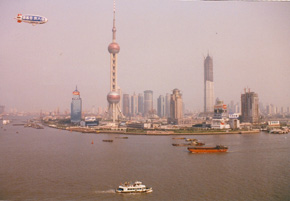
The Shanghai skyline Most travelers either begin or end their China travels where the mighty Yangtze empties into the South China Sea, in the flamboyant city of Shanghai. Some have dubbed Shanghai the new "financial center" of Asia, and signs of prosperity are everywhere. I have never seen so much neon in one place. At night, Nanjing Road is a flashing, throbbing, mass of humanity, all of them loaded down with large shopping bags. This pulsing neon jungle is reminiscent of Shanghai's bawdy past. In the late 1800's the city was home to the heavyweights of the world's finance and commerce industries, and the grand colonial buildings housed banks, gambling joints and opium dens. It was during this time that the city earned it's reputation for glamour and sleaze.
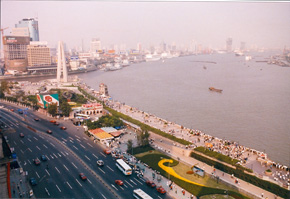
The Shanghai waterfront promenade One of the most attractive features of the new Shanghai is the waterfront promenade called The Bund, (an old Persian name). Back in the heyday, when the foreign trading companies were building offices here, the Chinese government forbid them from constructing directly on the river. The muddy banks were kept clear for the "trackers", men who used ropes to guide the heavily loaded junks safely up river. Today The Bund provides some welcome open space in this crowded city. It's the scene of morning "Wushu" or martial arts practice, ballroom dancing and cultural celebrations.
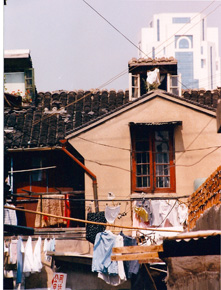
Old Shanghai neighborhood Chinese Tea CultureBustling Shanghai provides a first hand look at modern China as it collides with it's own ancient culture. Traditional architecture is replaced by skyscapers, and the elegant tea ceremony survives side by side with neon signs advertising the latest hi-tech toys. Tea Houses have always been an important part of Chinese culture. Through the centuries they have been a place where people could indulge in conversation and the arts. During Mao's cultural revolution these gathering spots were considered politically threatening and closed down, today they thrive in every corner of China. The local tea house is a great place to people watch. Some tea houses attract tourists from all over the world, while others cater to the regular neighborhood customers. The formal tea ritual serves the green brew in meticulous and acrobatic fashion with glasses first heated then each poured with great ceremony.
Outside Shanghai - Suzhou & Zhouzhuang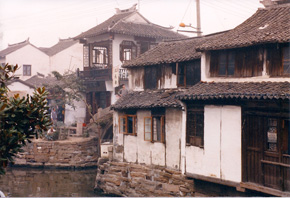
Suzhou China There isn't much "old world charm" left in modern China, but just outside Shanghai, two ancient villages have been preserved. After the bright lights and chaos of Shanghai, the tree-lined streets, traditional architecture, artistic gardens, and romantic canals of Suzhou and Zhouzhuang are a real breath of fresh air.
In Suzhou we rented bicycles and rode out into the countryside to check out the "Grand Canal", the longest man made waterway in the world. It was built in 600 AD to strengthen trade routes between Northern and Southern China and was a major contributor to the empire's prosperity. It still sees considerable traffic and makes a great place to hang out on a bridge, watch the local fishermen, and inspect the harvest of the passing farmers.
During the sixteenth century, the wealthy residents of Suzhou built traditional gardens that are works of art. The gardens are composed of ponds, waterfalls, temples, walking paths and rock gardens, and for centuries have offered a place for quiet contemplation and a respite from hectic city life.When Marco Polo visited Suzhou in 1276, he found a thriving silk industry, which still exists today. If you have any interest in artwork or embroidery, you will enjoy a visit to the Silk Institute. I was amazed by the incredibly intricate embroidered pictures the women create. The artists are using not a single silk thread, rather filaments, about one sixth the thickness of a human hair! It takes a year to finish just one picture of a cat and eighteen different colors to make the eye of the cat. I wondered how long their eyes last!
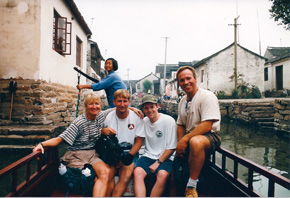
Waterways of Zhouzhuang China The Yangtze delta region is crisscrossed by natural waterways and canals, which serve as major transportation corridors. In the small village of Zhouzhuang, the traditional architecture and way of life has been preserved. You can drift in a small boat through a maze of canals and under stone bridges, enjoying a glimpse of China's historic past.
Check out more China travel information: Beijing and The Great Wall of China |
Sign up for email updates and newsletters from Julie: on locationTravel dispatches and trip ideas:
|
|||||||||||||||||||
|
| |||||||||||||||||||||
|
© 1999-2011 Passport To Adventure. All rights reserved. | |||||||||||||||||||||
|
| |||||||||||||||||||||

Inspiring Television that ignites a PASSION for TRAVEL & DISCOVERY!

Meet Julie and The Crew of the adventure travel TV series Passport to Adventure!



 Julie's latest
Julie's latest
